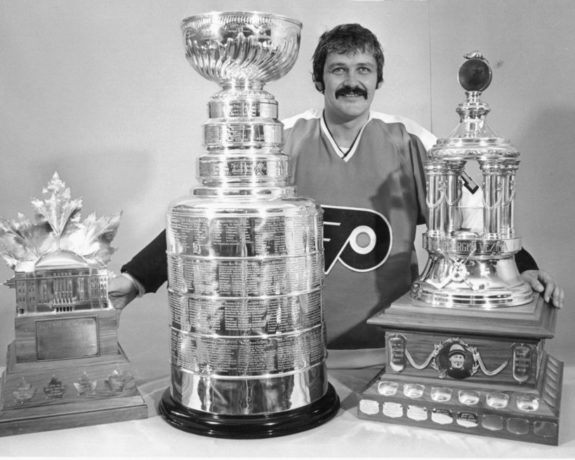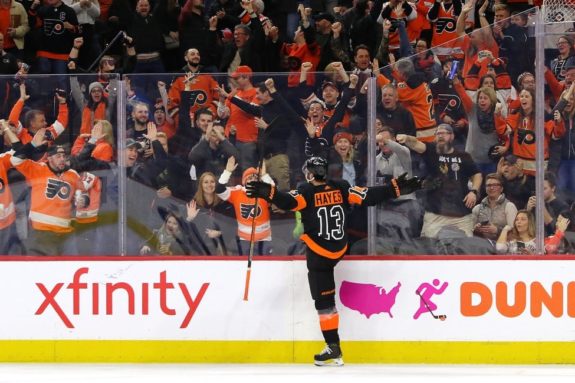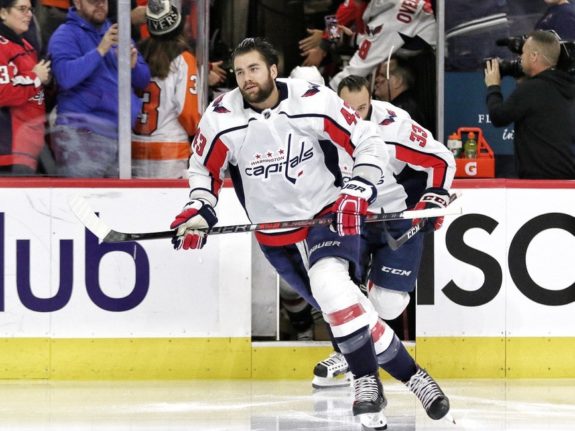The Philadelphia Flyers once held prominent stature in the NHL as an intimidating force that imposed their will on opponents. They revolutionized the sport of hockey during the notorious Broad Street Bullies era of the mid-1970s when they earned the franchise’s only two Stanley Cups. They continued with their organizational identity as ferocious competitors through a successful era during the 1980s and to varying extents during a streak of 16 playoff appearances in 17 seasons from 1995-2012.
The Flyers have allowed all semblance of an organizational identity to fade away in recent seasons. Their Stanley Cup drought has reached 46 years, and they have missed the playoffs in five of the past nine seasons after previously failing to qualify only eight times in franchise history. They will not compete with the top ranks of the NHL without regaining the missing identity.
The Beloved Broad Street Bullies
The mantra of the Broad Street Bullies captured the hearts of the Philadelphia fan base during the 1970s and legitimized the stature of the Flyers following their formation in 1967. While the intimidating reputation of the Bullies was gained somewhat through the bloody fights they endured, their ability to drop the gloves was far from their biggest weapon.
In an interview with Sports Illustrated, former Flyers winger Bob “The Hound” Kelly pointed out that, “What gets lost in the mix is that it wasn’t the fighting that changed the team, it was the talent on the team that changed it.” Former Flyers forward and long-time NHL broadcaster Bill Clement also referred to a “pack mentality” that created a bond of team chemistry and togetherness.

The Flyers of the 1970s brought “an offensive punch, hit hard, regularly pushed the limits of the rulebook, and backed it all up with literal punches if the situation deemed them necessary,” according to Kyle Gipe of The Hockey Writers. Hockey is largely predicated on time and space, and the physical strength and intimidation of the Broad Street Bullies created just that for skilled scorers like Bobby Clarke, Reggie Leach, and Billy Barber. The superb goaltending of Hall of Famer Bernie Parent also helped carry the Flyers to consecutive Cups in 1974 and 1975 and a return to the Final in 1976.
Flyers Fail to Restore Organizational Identity
Expectations for a new era of Flyers hockey heightened when the team finished their most successful regular season in almost a decade in 2019-20. They established themselves as a solid contender for a playoff spot in the Eastern Conference during the first half of the season. An increased development of continuity began to produce results once the calendar flipped to 2020. They gained momentum in January and early February before going on a nine-game winning streak spanning from mid-February through early March. They won their opening-round series for the first time in eight years against the Montreal Canadiens during the 2020 Stanley Cup Playoffs in the Toronto bubble.
It seemed that an era of rebuilding and unceremonious first-round playoff exits had finally come to an end. The hiring of head coach Alain Vigneault and the acquisitions of center Kevin Hayes and defenseman Matt Niskanen sparked life into the Flyers dressing room. Winger Travis Konecny appeared to be blossoming into a role as a scrappy top-six winger who could put the puck in the net just as well as he could irritate his opponents. Hayes quickly joined veterans Claude Giroux and Jakub Voracek as a prominent face of the team’s leadership group.

Their ferociously aggressive forecheck became the team’s true strength, and the spirit of determination and force seemed like it had once again been infused into the organization after a long period of mediocrity. Former first-round pick Scott Laughton, rookie winger Nicolas Aube-Kubel, and veteran depth forward Tyler Pitlick brought an aggressive physical style that complemented the efforts of the top-line players and made the Flyers a tough team to face on a nightly basis.
The disappointment of the 2020-21 season slowed any sort of momentum that the organization gained from the apparent turn of the corner into a new era in 2019-20. The Flyers lost their team identity from the previous season, and a major reason for their regression was the lack of spirited physical play from the team collectively.
Hayes experienced a significant dropoff in his play that hurt the personality and confidence level of the team. Konecny didn’t seem as engaged as a pesky agitator making life difficult for opposing defensemen. Laughton showed flashes of the grit that has earned him high regard among teammates, but he was clearly affected physically after suffering from COVID-19 midseason. Pitlick moved on to the Arizona Coyotes, and Aube-Kubel’s play was ineffective. The Flyers suddenly lost their ability to win puck battles and create time and space for their teammates. Their inability to protect the front of their own net negatively affected the performance of 22-year-old goalie Carter Hart throughout the season.
Their physical play paled in comparison to rival teams in the temporarily formed MassMutual East Division. The Flyers sat at home while the New York Islanders, a physically imposing division rival that eliminated them from the 2020 Playoffs largely due to a grinding and heavy style, advanced to the Semifinal.
Flyers Look To Build Team With Tougher Mindset
The notion that the Flyers need to get tougher is sometimes looked at as an archaic stance because of the NHL’s innovation into more of a finesse style in recent years. The public perception of teams that play near the limits of the rulebook has grown increasingly negative. However, the need for physical play and the creation of time and space still persists. Bill Meltzer, as a guest on the Flyers Daily podcast with Jason Myrtetus last week, pointed to the need for grit and toughness as an “element of team building that is still a necessary part of the game.”
Meltzer added, “As much as you may dislike certain things that a player like Tom Wilson does, for example, you cannot deny that when Tom Wilson is on the ice, everyone’s head is on a swivel, and his linemates have more room to operate.” Wilson is the face of negative fan attention surrounding physical play and fighting in the NHL. However, his style of play has proven valuable for the Washington Capitals. Myrtetus went on to point out the value of similar contributions from Pat Maroon, Barclay Goodrow, and Blake Coleman for the Stanley Cup champion Tampa Bay Lightning.

Flyers general manager Chuck Fletcher should take note of the success of organizations that prioritize this physical style. He must see the need for the Flyers to match up with Islanders forwards like Anders Lee (6-foot-3, 235 pounds) and Brock Nelson (6-foot-4, 212 pounds) next season. He undoubtedly recognized his team’s lack of aggressive fire when Swedish winger and respected cancer survivor Oskar Lindblom was forced to drop the gloves in a March matchup against the Islanders.
Fletcher would be wise to pursue Goodrow or Coleman, both impending unrestricted free agents (UFA), or 6-foot-7 Dallas Stars defenseman Jamie Oleksiak this offseason. Although the asking price in a potential trade for winger Matthew Tkachuk of the Calgary Flames might be steep, the Flyers could certainly use a player of his scoring acumen who can get inside the heads of his opponents. Islanders’ depth forward Casey Cizikas reasonably fits well into the Flyers’ plans also.
Hayes successfully underwent sports hernia surgery in the offseason, and Laughton will presumably be back healthy. The Flyers will hope for a rebound season from Konecny in which he resumes the agitator role. The need for players within the organization and potential acquisitions from outside the organization to provide the presence of grit and physicality will be a major factor in determining the ability of the Flyers to emerge from a disappointing era of mediocrity with a stronger effort in 2021-22.